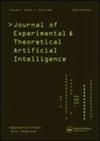Weighted holoentropy-based features with optimised deep belief network for automatic sentiment analysis: reviewing product tweets
IF 1.7
4区 计算机科学
Q3 COMPUTER SCIENCE, ARTIFICIAL INTELLIGENCE
Journal of Experimental & Theoretical Artificial Intelligence
Pub Date : 2021-08-30
DOI:10.1080/0952813X.2021.1966839
引用次数: 0
Abstract
ABSTRACT In this paper, a novel sentiment analysis model is implemented, which consists of six stages: (i) Pre-processing, (ii) Keyword extraction and its sentiment categorisation, (iii) Semantic word extraction, (iv) Semantic similarity checking, (v) Feature extraction, and (vi) Classification. Initially, the Mongodb documented tweets are subjected to pre-processing that includes steps such as stop word removal, stemming, and blank space removal. Accordingly, from the pre-processed tweets, the keywords are extracted. Based on the extracted keywords, the prevailing semantic words are extracted after classifying the sentimental keywords. Further, the evaluation of the semantic similarity score with the keywords takes place. Also, it exploits joint holoentropy and cross holoentropy. Here, the extraction of weighted holoentropy features is the main contribution, where a weight function is multiplied by the holoentropy features. To improve the performance of classification, a constant term is used for calculating weight function. It is tuned or optimised in such a way that the accuracy of the proposed method is better. The optimisation strategy uses the hybrid model that merges Particle Swarm Optimisation (PSO) into Whale Optimisation Algorithm (WOA). Hence, the proposed algorithm is named as Swarm Velocity-based WOA (SV-WOA). Finally, the analysis is done to prove the efficiency of the proposed model.基于加权全熵的特征与优化的深度信念网络用于自动情感分析:审查产品推文
本文实现了一种新的情感分析模型,该模型包括六个阶段:(i)预处理,(ii)关键字提取及其情感分类,(iii)语义词提取,(iv)语义相似度检查,(v)特征提取和(vi)分类。最初,Mongodb记录的tweet要经过预处理,包括删除停止词、词干提取和删除空白等步骤。相应地,从预处理的tweet中提取关键字。在提取的关键字基础上,对情感关键字进行分类,提取出流行的语义词。进一步,评估与关键词的语义相似度得分。同时利用了联合全熵和交叉全熵。在这里,加权全熵特征的提取是主要贡献,其中权函数乘以全熵特征。为了提高分类的性能,我们使用一个常数项来计算权重函数。它以这样一种方式进行调整或优化,使所提出的方法的准确性更好。该优化策略采用混合模型,将粒子群优化(PSO)算法与鲸鱼优化算法(WOA)相结合。因此,本文提出的算法被命名为基于群速度的WOA (SV-WOA)。最后,通过分析验证了所提模型的有效性。
本文章由计算机程序翻译,如有差异,请以英文原文为准。
求助全文
约1分钟内获得全文
求助全文
来源期刊
CiteScore
6.10
自引率
4.50%
发文量
89
审稿时长
>12 weeks
期刊介绍:
Journal of Experimental & Theoretical Artificial Intelligence (JETAI) is a world leading journal dedicated to publishing high quality, rigorously reviewed, original papers in artificial intelligence (AI) research.
The journal features work in all subfields of AI research and accepts both theoretical and applied research. Topics covered include, but are not limited to, the following:
• cognitive science
• games
• learning
• knowledge representation
• memory and neural system modelling
• perception
• problem-solving

 求助内容:
求助内容: 应助结果提醒方式:
应助结果提醒方式:


